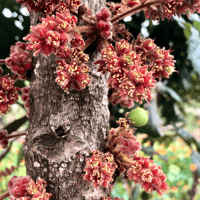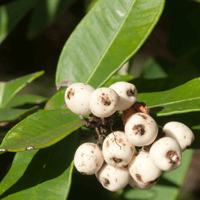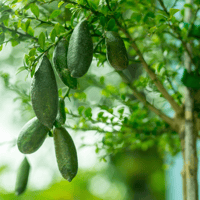We have the most intriguing and delicious bush tucker plants in this magical country, but do we delve into the gardening and production of these plant species enough in our backyard?
Below is a list of native Australian plants that will provide you with a tasty fruit or nut harvest.
Small leaved Tamarind (Diploglottis campbelli)
- 8m tall, rare rainforest tree, native to Northern NSW. Can be grown as a highly ornamental shade tree or even grown in a pot.
- Tangy flesh is delightful as a sharp sauce or chutney and also goes with cheeses, fruit salsas and cold meats. Can be eaten raw.
 Davidson’s Plum (Davidsonia pruiens var. pruiens & D.jerseyana)
Davidson’s Plum (Davidsonia pruiens var. pruiens & D.jerseyana)
- This is a slender rainforest tree species growing to around 6-8m in a garden situation. Shade to semi-shade. Vibrant red new growth.
- The fruit grows off the trunk and have dark purple skin with red flesh. They are extremely tart.
- Best cooked for sweet or savoury dishes. Jams, jellies, wine.
Native Raspberry (Rubus rosiflorus, probus, moluccans, fraxinifolius)
- Some are suckering shrubs to 1.5m tall – best grown in pots and some species are ramblers.
- Sunny to semi-shaded position.
- Eaten fresh, jams, desserts, savoury.
- Great ‘on the run’ edible treat in the backyard for children.
 Midyum Berry (Austromyrtus dulcis)
Midyum Berry (Austromyrtus dulcis)
- The fruit, small white speckled berries, are best eaten fresh (seeds and all) and the flavour can range from very sweet to aromatic menthol flavour.
- Great ‘on the go’ kid snack to have in the backyard.
- Native to NSW and QLD this delightful little shrub/ground cover grows in a semi-shaded location.
Lilly Pilly (Syzygium spp). Best species for fruit:
- Syzygium oleosum ‘Blue Lilly Pilly’.

- Syzygium leuhmannii ‘Riberry’.
- Syzygium australe ‘Magenta cherry’ – ‘Brush cherry’.
- All lilly pilly species have edible fruit coming in a range of colours from white to purple.
- The heights and sizes vary, depending on species.
- Full to semi-shade. Hedges, specimen plant, pot plant, tree.
- Fruit can be used for jams, jellies, juices, sauces, sweet & savoury dishes and fresh as is.
Pigface (Carpobotrus glaucesens)
- It is the maroon berries that are produced after flowering that are eaten - they have a salty kiwi fruit/strawberry flavour to them. The fruit is generally eaten by sucking out the flesh and discarding the skin or turned into jam.
- The foliage can also be eaten fresh or cooked, can be used in pickles.
- Succulent perennial spreading groundcover plant with white or vibrant pink/purple flowers. Drought hardy.
 Fingerlime (Citrus australascia)
Fingerlime (Citrus australascia)
- 4-6m full sun to semi-shade.
- Naturally found growing on rainforest edges and has very thorny branches.
- Can be grown in pots (acidic mix).
- The juice is held within 100’s of tiny structures inside the fruit.
- This flesh has a strong flavour and can be used in juices, sauces, desserts, Thai food, seafood, chicken, pavlovas, tacos, scallops, jams, champagne, or non-alcoholic carbonated drinks.
Other great choices;
- Macadamia nut: Macadamia integrifolia
- Blue Quandong: Elaeocarpus angustifolius (syn E.grandis)
- Lemon Aspen: Acronychia acidula
- Native Guava: Eupomatia laurina
- Black Apple: Planchonella australis
- Burdekin Plum: Pleiogynium timorense
- Brown Pine: Podocarpus elatus
- Native Elderberry: Sambucus australasica
- Blackberry Jam Fruit: Randia formosa
Looking for more great gardening info like this? Subscribe to the Better Earth Program to receive Better Earth Secrets Magazine direct to your inbox each season.
_MEB.png?width=842&height=596&name=RP_HorizontalColour(R)_MEB.png)



